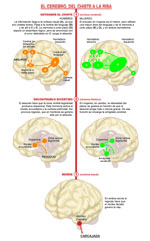Humor and flexible mind: men tell more jokes and women laugh more
An informative video from the University of Navarra analyzes and summarizes what science has to say about humor and brain
Because of its linguistic processing, humor is genuinely human and follows different brain strategies for men and women. This is one of the conclusions that cutting-edge neurosciences reveal and that the University of Navarra summarizes in an informative video presented in Madrid. The authors are Natalia López Moratalla, Professor of Biochemistry and Molecular Biology; Carlos Bernar, specialist in Audiovisual Communication; and Enrique Sueiro, PhD in Biomedical Communication.
The video includes research by British Professor Richard Wiseman and his laboratory of Laughter, as well as articles from scientific journals: Nature Neuroscience y Proceedings of the National Academy of Sciences (PNAS), among others. The summary sample schematically shows what happens in the brain from the moment we are told a joke until we laugh.
Natalia López Moratalla points out that a sense of humor requires an agile and flexible mind. She summarizes the development in which the three layers of the brain intervene: "First we use areas of the cerebral cortex to process words and realize that what we have heard or read does not make sense. Then we use the area that processes feelings. There, what is absurd or funny generates a pleasant emotion. Dopamine, known as the happiness hormone, which activates the reward system by stimulating the central switch, called the nucleus accumbens, is involved. Once activated, this switch sends happiness signals to the prefrontal cortex. Finally, "the reward and pleasure system is responsible for generating the euphoric reaction, laughter, from the third layer of the brain."
The best jokes
 |
| Click on the image to enlarge it. |
The most laughed-at jokes are often characterized by the use of puns to create absurd situations. In general, women use more brain areas and, above all, integrate more emotional aspects into various processes, including cognitive ones, than men. According to the expert, the greater brain activation in the prefrontal region in women suggests a greater use of the report short deadline in the processing of coherence, mental turning, verbal abstraction, self-directed attention and analysis of what is relevant.
Professor López Moratalla compares the brain process of humor between men and women to a subway map: "Although the points of departure and arrival coincide, women use more stations and involve more travel. In both men and women, grasping the absurd is rooted in the specifically human capacity of the executive brain to store, manipulate and compare interdependent elements".
He adds that grasping the absurd, as the information reaches the so-called "error detection center" of the brain, is rewarded by an increase in dopamine. For men, the illogical is enough for a sense of humor. Women require the absurd to be funny and thus provoke the emotion of the funny. In them the switch is activated in direct relation to the humorous intensity.
Laughing extends life
In any case, the video points out that laughter and good humor are biologically useful. People who counteract stress with humor have a healthy immune system; they suffer 40% fewer heart attacks or strokes, suffer less pain during dental treatment and live four and a half years longer. That is why scientists recommend laughing at least 15 minutes a day. When negative feelings last a long time, they cause exhaustion and damage the organism.
The professor of the University of Navarra concludes that "humor and happiness are genuinely human and are associated with getting along well with oneself and one's environment. For this, above all, the meaning of life and relationships with others are important. If you can laugh at the impediments to happiness, you can overcome them".
The video presented is already available on YouTube and is part of the University of Navarra's project The secrets of your brain which, in twenty simple videos, aims to analyze, summarize and communicate what cutting-edge neuroscience has to say about the brain.
More material available at:
http://www.unav.es/servicio/comunicacioncientifica/Lossecretosdetucerebro
